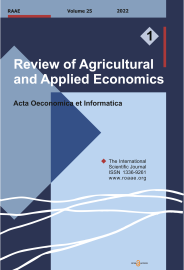KEYWORDS:
technical, allocative, economic efficiencies; double-hurdle, PSM models
DOI NUMBER:
10.15414/raae.2019.22.02.10-17
ABSTRACT:
In Ethiopia, sesame is mainly cultivated as a cash crop, important source of foreign exchange and income for many smallholders. Thus, improvement in production efficiency of sesame is crucial for Ethiopian economy and for smallholder farmer’s livelihood. Socioeconomic, demographic and institutional factors were collected from randomly selected 385 sample households using multi-stage sampling techniques and interviewed using semi-structured questionnaire. The Cobb-Douglas stochastic frontier production function result shows that all input variables except land was positive and significant effect on sesame production efficiency. Labour inputs have the highest elasticity, followed by sesame seed, pesticides/herbicides and fertilizer accordingly. The model result shows that across all mean technical, allocative, and economic efficiencies estimates are 72, 49 and 35 percent respectively, implies that a substantial level of inefficiency in sesame production. Improvement of production efficiency requires availability of enough labour particularly during harvesting because of its shattering problem. Therefore, the local and regional government needs to devise mechanisms for hired labour availability in the area. Moreover, the econometric model result indicates that sesame production efficiency was positively and significantly influenced by age, education level, livestock ownership, association membership, off/non-farm income, extension contact, credit access, mobile phone ownership and training participation. The key policy implication therefore is that promoting farmer’s cooperatives, address farmers in formal and informal education programs, enhancing farmer’s access to financial resources through providing easy and affordable credit services, strengthen the extension services in terms of promoting livestock and crop production improving technologies are crucial.
Please Cite this Article as:
Adugna GELA, Jema HAJI, Mengistu KETEMA, Hebtemariam ABATE (2019) Technical, Allocative And Economic Efficiencies Of Small-scale Sesame Farmers: The Case Of West Gondar Zone, Ethiopia. Review of Agricultural and Applied Economics. XXII (Number 2, 2019): 10-17. doi: 10.15414/raae.2019.22.02.10-17
URL for sharing:
https://roaae.org/1336-9261/doi/abs/10.15414/raae.2019.22.02.10-17
FULL TEXT PDF:
▼ direct download link| view online in fullscreen ▲
References:
▼ direct download link

